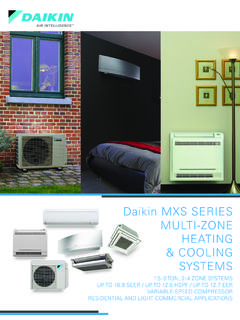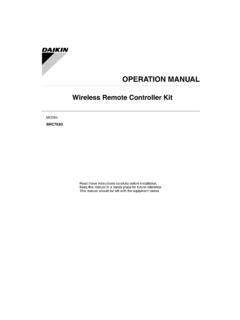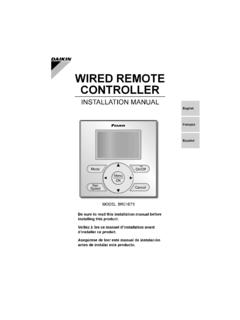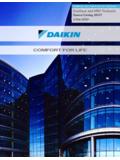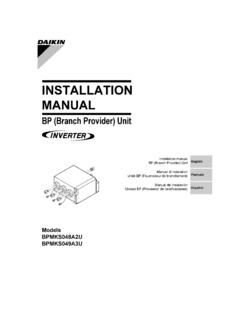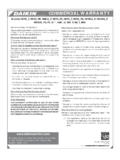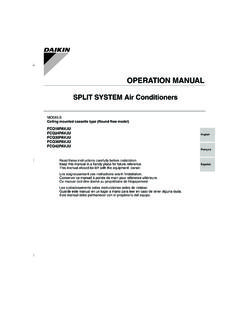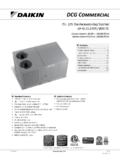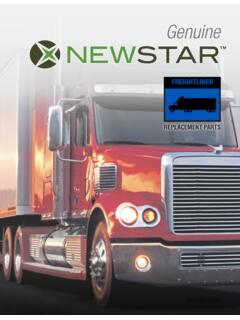Transcription of APPLICATIONS IN EXTREME CLIMATE CONDITIONS
1 APPLICATIONSIN EXTREME CLIMATE CONDITIONS About Daikin: Daikin Industries, Ltd. (DIL) is a global Fortune 1000 company, which celebrated its 90th anniversary in May 2014. The company is recognized as one of the largest HVAC (Heating, Ventilation, Air Conditioning) manufacturers in the world. DIL is primarily engaged in developing indoor comfort products, and refrigeration systems for residential, commercial, and industrial APPLICATIONS . Its consistent success is derived, in part, from a focus on innovative, energy-efficient, and premium quality indoor CLIMATE and comfort management WORLD LEADING MA NUFAC T URER OF HVAC PRODUCTSOPERATINGF O U N D E DIN 1924R E S E AR C H DEVELOPMENT OVER $300 MILLIONOVER 60,0000 DAIKIN VRV SYSTEMSTHROUGHOUT NORTH AMERICA3 ContentsIntroductionIs VRV suitable in most environments?
2 5 Core benefits of Daikin VRV5 Standard operation limits5 Defining operation and performance5 Dangers of Oversizing6 Correct SizingSelection method using VRV Xpress7 Considerations for AltitudeCapacity de-rate charts8 Considerations for Adverse WeatherOutdoor unit location9 Considerations for condensate9 Protection against snow and hail10 Cooling in Hot and Humid ClimatesOutdoor unit location11 High humidity control11 Outside air limitations12 Cooling in Cold ClimatesDesign limitations13 Considerations and recommendations14 Heating in Cold ClimatesUse of secondary heat source15 Installation strategies17 Use of the Cold CLIMATE Analysis or VRV suitable in most environments?Yes. There are many obstacles to overcome and, like all heating and cooling systems, attention to design, capacity and application will be required, however all the reasons to use VRV in the first instance still benefits of Daikin VRV Modular design Quick and easy to install High energy efficiencies even in EXTREME CONDITIONS Exceptional comfort control All control parameters remainStandard operation limits air cooled systemsVRV-IV has a wide range of operating ability and performance data covering a wide spectrum of operation range for both cooling and heating.
3 The ability to provide cooling up to ambient CONDITIONS of 122 F covers ASHRAE design CONDITIONS for all regions of North America As standard, VRV heat recovery can operate in heating down to -13 F Daikin VRV AURORA Series Heat Recovery Systems can operate in heating down to -22 F Some regions require design at ambient temperatures outside this range This does not negate the ability to use VRV in these EXTREME climates There are several design practices that allow the use of VRV equipment and still take advantage of the system's benefitsDefining operation and performanceRange of operation Backed by performance data, Daikin VRV equipment provides continuous operation within the range indicated There is no factory default software based lock out of operation preventing system operation outside of these conditionsPerformance data Daikin has performance data for the entire operation range of VRV equipment It is possible for heat pump and heat recovery systems to operate in cooling down to 10 F and -4 F ambient, respectively ( CONDITIONS apply)
4 Performance data for heat pump VRV from -4 F down to -13 F is available upon request122 F77 F23 F10 FVIA extended capacity tables-4 F-13 F-22 FAmbientHeat Pump Heat RecoveryCOOLINGCOOLINGHEATINGHEATINGAURO RA Series Standard Operating RangeSIMULTANEOUSVIA technical cooling functionCooling operation for VRV IV Heat Pump single module systems (RXYQ72/96/120/144/168T) can be extended down to 10 F, from the standard limitation of 23 F under defined your local Daikin manufacturer s representative or distributor for or of OversizingOversized for coolingDespite advanced control methods, oversizing of equipment, even with Variable Refrigerant Volume technology, can lead to indoor units overcooling the space and cycling on and off. This results in poor temperature addition to large temperature swings, an indoor unit that cycles on and off does not provide continuous de-humidification.
5 Oversized for heatingIn areas of very cold climates, there is a temptation to up-size indoor units in the belief that this ensures capacity in EXTREME CONDITIONS below design reality is correct load calculation and good design ensures the best heating mode, the expansion device never fully closes. Therefore a unit that continuously cycles on and off will, in time, see a steady increase in temperature above set TemperatureRoom TemperatureTime123456789101112131415 TimeCooling ModeOPTIMALOVERSIZEDSET POINTOPTIMALOVERSIZEDSET POINTH eating Mode646668707274767880826466687072747678 8082123456789101112131415 Room TemperatureRoom TemperatureTime123456789101112131415 TimeCooling ModeOPTIMALOVERSIZEDSET POINTOPTIMALOVERSIZEDSET POINTH eating Mode7 Correct SizingUsing traditional rules of thumb to size HVAC equipment can lead to oversizing of equipment as construction methods have changed from the days when the 500 ft per ton or 400 cfm per ton was the standard one-size-fits-all solution for residential, light commercial, and commercial buildings.
6 The latter is especially true with VRV indoor units typically operating at 320~350 cfm per , replacing like-for-like tonnage equipment in a retrofit application can lead to oversizing of equipment as the building may have improved heat gain efficiencies, been upgraded or the usage of the space has been Cooling and Heating Load Engineers will provide total and sensible loads sizing is possible when either is provided. Required when either heating is the dominant operation or the heating design condition is below 3 2 UnitOutdoor UnitAmbient ConditionsThe design ambient for the location of the project Both engineers and D&B contractors should have this information. ASHRAE standard design CONDITIONS for the location are easily Air ConditionsThe dry and wet bulb temperatures entering the coil.
7 Also known as air-on or mixed air CONDITIONS . Design air-on can also be given as db/RH% (eg 74 F and 50% RH).Pipe Length Longest linear length, NOT the total amount of piping. Both engineers and D&B contractors should be able to pin point the outdoor unit Method using WEBX pressThe WEBX press Selection Tool provides the platform to convert these design CONDITIONS to a quick and accurate selection of VRV Peak Cooling load demands are entered for the area to be served in addition to the correct design (mixed air) an indoor unit based on its nominal capacity will usually cause a unit to be oversized. In addition to poor performance, there is the obvious disadvantage of increased project sizing the VRV outdoor unit, design ambient CONDITIONS are added in the outdoor unit selection ensure optimum accuracy of design, an indication of the expected pipe length should also be entered at this Selection PanelsThe minimum information needed to produce accurate and optimized equipment selection on a or for AltitudeWhen using VRV in regions of high altitude, the impact of air density on total capacity should be accounted for.
8 Daikin has produced charts for calculating the de-rate amounts that would need to be applied to the VRV equipment. There are TWO charts One for indoor units and one for outdoor Factor Indoor UnitsAltitude (ft.) (ft.) : The de-rate that needs to be applied to all indoor unit selections @ 4,500 ft. elevation is by interpolationCorrection Factor Air-Source Outdoor UnitsThe metrics for the outdoor units differ from the indoor units because Daikin VRV outdoor units have the ability to compensate for some of the performance losses due to air pressure drops at high (ft.)10002000300040005000De-Rate (%) (ft.)600070008000900010000De-Rate (%) : the de-rate that needs to be applied all Outdoor unit selections @ 4,500 ft. elevation is by interpolationNote: Since WEBX press does not account for air density correction automatically, indoor unit tolerances and outdoor unit loads at high altitude would need be entered for Adverse WeatherOutdoor Unit Locations Wind-chill can have a direct effect on the performance of an outdoor possible, locate the outdoor condensing unit in a location sheltered from the prevailing this is not possible, it is recommended to construct baffle plates to mitigate the effect (Figure 1).
9 Condensate Drainage During defrost operation, condensate is generated. Ensure that condensate can adequately escape from the outdoor unit bottom plate by utilizing a mounting stand. This will prevent the trapping or build up of condensate in the bottom section of the unit, that could freeze in harsh climates. Make sure drainage water is routed away from walkways, etc. to prevent slipping or other ground hazards if it ensure optimum capacity, performance and correct defrost in cold, snowy or high winter humidity areas, several factors should be considered in the design of your VRV Construct a large canopy2 Add baffle plates3 Construct a pedestal3 Baffle Plate2 Figure 1 Figure 2 Considerations for Snow Install the units on a pedestal or mounting stand at a sufficient height from ground level and clearances from walls to address regional snow or drift levels.
10 In areas where snow fall or drift is minimal, installation of a (field fabricated) baffle plate is recommend, in addition to a canopy placed above the outdoor unit (Figure 2). In situations where this is not addressed, it may be necessary to employ corrective maintenance routines after heavy snowfall to clear snow away from any affected : These illustrations are for reference only. For more details contact your local Daikin representative or #mal External Loca#ons Prevailing Wind or for Adverse WeatherHeavy Snow Areas In areas where snow fall or drift is significant, field fabricated snow hoods can be added to the outdoor units. Daikin provides snow hood spec drawings for this purpose. These hoods are also suitable to protect outdoor units exposed to prevailing winds in EXTREME low ambient Guards Outdoor coil protection from hail storms is available.
